Trial well onshore Canada verifies dual drill string drilling method, enables managed gradient drilling
New heavy-over-light drilling fluid solution was also incorporated to solve torque, drag, hole cleaning and ECD control problems
By Ola M. Vestavik and John Thorogood, Reelwell; Etienne Bourdelet, Total; Bernd Schmalhorst and Jan Petter Roed, DEA Deutsche Erdoel AG
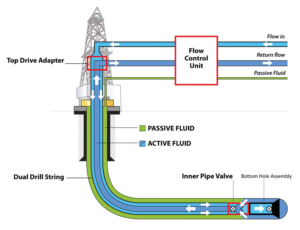
A shallow horizontal trial well was drilled onshore Alberta, Canada, in March 2016 to verify a new drilling method that incorporates a dual drill string, with a separate channel for the return fluid from the well. This arrangement enables managed gradient drilling, i.e. drilling with a constant downhole pressure gradient that can be controlled to be nearly independent of the flow rate.
The solution is similar to managed pressure drilling (MPD). It differs in that the downhole pressure gradient is managed instead of the pressure at one depth in the well. This method of equivalent circulating density (ECD) control provides efficient hole cleaning at low flow rates and enables torque and drag reduction due to buoyancy of the drill string.
For the Alberta well, new drilling equipment, including a newly designed aluminum dual drill string, was used. New drilling procedures were employed, including the new heavy-over-light drilling fluid solution.
The dual drill string configuration was developed such that:
• Drill cuttings are removed from the bottom hole through a separate flow channel inside the drill string;
• Managed gradient drilling creates a constant downhole pressure gradient that is independent of the flow rate; and
• Torque and drag: the heavy over light fluid solution reduces torque and drag due to buoyancy.
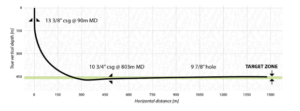
Figure 1 presents a schematic of the drilling fluid flow. The dual drill string allows drilling mud to be pumped down the annulus inside the drill pipe, with the return flow up the concentric inner pipe. The system can be installed on a standard drilling rig. A top drive adapter connects the rig’s top drive to the top of the dual drill string. It contains a swivel that allows for pumping mud into the drill pipe annulus and for the return flow from the inner pipe to be directed back to the surface mud system. The lower end of the dual drill string connects to a standard bottomhole assembly by means of an inner pipe valve, which contains entrance ports for the return fluid and isolates the well during pipe connections.
A flow control unit is a key element to control the drilling fluid flow; it is a skid on which chokes, valves and sensors for pressure, temperature and flow are mounted. The unit is positioned near the rig and remotely controlled from a screen unit in the driller’s cabin. The flow control unit regulates the flow into and out of the well, in order to keep a near constant downhole pressure gradient during drilling operations. A rotating control device at the top of the BOP is used for the well pressure control during operation.
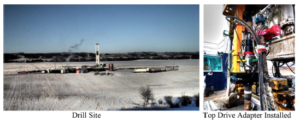
The dual drill string configuration allows two types of fluid to be used in the well during drilling. A low-density and low-viscosity active drilling fluid is circulated inside the dual drill string and around the BHA. The annulus outside the dual drill string is filled with a near-static passive fluid, preferably a fluid optimized for torque and drag reduction and for downhole pressure control.
This heavy-over-light configuration results in the passive well annulus fluid having a greater density than the active fluid inside the dual drill string. It also means the dual drill string is exposed to positive buoyancy forces due to the differences in fluid densities inside and outside the string. The buoyancy forces result in a reduction of wall contact forces, thereby leading to a reduction in the torque and drag during drilling.
Operation

The target for the horizontal well in Alberta, Canada, was a zone between about 450-470 m TVD that was predicted to be a relatively homogenous sand with no hydrocarbons.
The flow control unit and its control panel enable remote control of system functions, data logging and sensor monitoring. The control unit software provides automated procedures for pump startup, shutdown, pressure control on selected set points and alarms with associated recommended actions.
The intermediate 13.5-in. hole section was directionally drilled with conventional 5-in. drill pipe down to 803-m MD, 465-m TVD. The 10 ¾-in. casing was cemented in place and a formation integrity test was conducted.
The specialized dual drill string, combined with a conventional rotary steerable system bottomhole assembly, was used for drilling the 9 7/8-in. horizontal section. A 1.1 sg water-based drilling fluid was used for both active and passive fluids down to 1,100-m MD. The fluid in the annulus outside the dual drill string was then displaced to a 1.6 sg density fluid to continue drilling the horizontal section in heavy-over-light mode. The remaining section to the target 1,510-m MD, 452-m TVD was drilled in this mode with active/passive fluid densities maintained at 1.1 sg/1.6 sg. The effect of the heavy-over-light
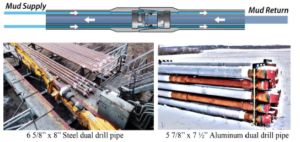
fluid configuration on torque and drag was measured at TD. Torque and drag readings were obtained first with the 1.1sg/1.6sg light/heavy fluid configuration. The well was then displaced to 1.6 sg in the well annulus and both channels of the drill string, and the measurements were repeated.
The well control procedures with the dual drill string were tested as a last part of the trial. After setting a bridge plug in the 10 ¾-in. casing at 783 m, nitrogen was displaced through the dual drill string and trapped in the casing at the plug, to create a volume of 430 l of compressed gas. During the subsequent circulation, the nitrogen was detected and circulated out of the well, in accordance with the well control procedure. The well was then abandoned.
Results
The rig had been cold-stacked prior to the operation. Problems with the electrical systems, as well as with the pumps and mud-handling system, had not been identified prior to start-up.
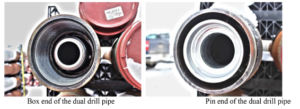
Target formation at around 460-m TVD was clay rather than sand, which caused problems with mud rings and associated delays of the upper 13 ½-in. hole section down to 804-m MD, 466-m TVD. The operation followed the plan closely after removing the rig-related downtime.
The left-side plots in Figure 2 present an example of surface and downhole data when drilling from 867- to 905-m MD in the single fluid mode, with the passive fluid in the well annulus outside the dual drill string having the same density as the active fluid circulating inside the dual drill string. The following points can be seen in the figure:
• The ROP is around 30 m/hr for the first two joints. The ROP increases to around 40 m/hr for the third joint at 905-m MD. The increase is probably due to the higher weight on bit for the third joint.
• The measurements from the PWD tool shows bottomhole pressure maintained within ±72.5 psi.
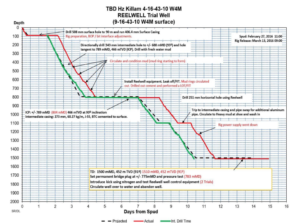
The right-side plots in Figure 2 give the same surface and downhole logging results when drilling from 1,246- to 1,283-m MD in the heavy over light. The rotational speed had been increased to more than 100 rpm, the ROP is more irregular than in the previous figure, and ROP values up to 50 m/hr can be observed.
Figure 3 presents results from the torque and hookload measurements when investigating the effect of the heavy-over-light fluid
configuration on the torque and drag of the drill string. The measurements were performed with the bit off bottom after completing drilling of the horizontal section to 1,510-m MD. The measurements were performed by slowly running into and out of hole, with and without drill string rotation.
The left side of the figure presents the measurements performed when the well annulus contains a heavy fluid with a density of 1.60 sg and both the inside channels of the drill string are filled with the light drilling fluid of density 1.15 sg.
The right side of the figure presents the measurements performed when the well annulus contains a heavy fluid with a density of 1.60 sg, and both the inside channels of the drill string are also displaced to the heavy drilling fluid of density 1.60 sg.
The torque values (red) during rotation on the left are, on average 6.4 kNm, whereas the corresponding torque reading on the right is averaged to 8.7 kNm. This confirms that the torque of the drill string in this case is reduced by around 30%, which is in agreement with the model. Precise measurements of the effect of the heavy-over-light configuration on drag are more difficult to interpret, due to the low overall loads and the hysteresis effects of other friction elements in the rig’s hoisting system. The figure indicates higher drag for the single fluid case, observed by the step-changes in hookload (blue) values when comparing the heavy-over-light and single fluid case.
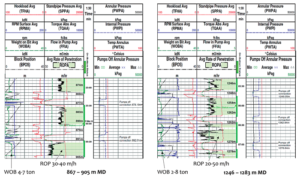
Since the formation was predominantly clay, the bulk of the cuttings were very small, less than 1 mm in size. However, when drilling occasional stringers, some larger cuttings sizes were observed. The bottoms-up time for the cuttings was estimated to be about 9 minutes at TD.
The density in the return fluid, measured by the Coriolis flow meter, increased throughout the operation, due to accumulation of fines from the drilled clay.
About 0.43-cu-m downhole volume of nitrogen was injected into the well and trapped at a bridge plug in the cased hole at 783-m MD. A short bottomhole assembly was used when running the drill string into the downhole gas volume while simultaneously circulating at 800 l/min at standard dual channel circulation. The test confirmed the ability of the flow control unit Coriolis flow meter to quickly detect gas in the well. The test also confirmed the ability of the system to monitor downhole pressures in the well annulus and to circulate out the gas in a controlled and safe manner. The second test gave similar results.
Figure 4 presents an example of the calculated pressure gradient in the trial well during the heavy-over-light drilling operation, with the pressure inside the well annulus and in the two channels of the dual drill string as a function of vertical depth. The following points can be observed:
• The purple line represents the pressure in the well annulus, created by the near-static heavy fluid, in this case with zero wellhead pressure.
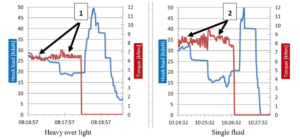
• The red and green lines indicate the upper and lower pressure limits in the well, here as an example of a small pressure window.
• The orange line represents the pressure inside the return flow path up the drill string. While the active circulating fluid is subjected to ECD to make it flow up the drill string, its pressure is lower than that of the passive fluid in the well annulus. However, the pressures of the two fluids are equal at the entrance ports of the inner pipe valve at the top of the BHA.
• The blue line on the far right is the pressure in the annulus of the dual drill string, and the gap to the purple line is the pressure drop at the bit. The standpipe pressure is slightly above 1,450.4 psi, as observed at 0 m TVD.
The pressure gradient in the well annulus is a constant straight line because heavy fluid in the annulus is almost static. The pressure gradient of the light active drilling fluid inside the return flow conduit is not a straight line, due to the hydraulic friction inside the inner string. This example shows the advantage of the dual string configuration over conventional circulation, where the hydraulic friction in the well annulus creates additional bottomhole pressure.
Discussion
The drilling operation from spud to abandonment was completed in 15 days. There was no downtime on the downhole drilling tools and equipment during the operations.
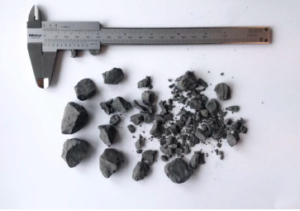
The surface and downhole logging results in Figures 2 and 3 show that high ROP was obtained for relatively low flow rates, compared with conventional drilling. The results indicate that the downhole pressure gradient is held constant to within 50 kPa during starting and stopping the mud pumps. Analysis of the downhole pressures indicated that the pressure variations during connections were in the range of 72.5 psi, when using start-stop times for the pump of 1-2 minutes when employing automated mud pump control procedures. If necessary, smaller pressure variations can be achieved by taking longer to ramp up from pump start-up to full circulation flow.
From the left-side plots in Figure 2, it can be noted that the time for a connection, from stopping drilling to starting drilling, is around 20 minutes. In the right-side plots of Figure 2, the same connection time is reduced to about 10 minutes. This can be observed to be a result of omitting the short washing and reaming operation at the end of each stand. The reaming operation was performed in the first part of the well but was later omitted as it showed no noticeable effect on hole cleaning.
The torque and drag measurements in Figure 3 show that the torque of the drill string was reduced by approximately 30%. The reduction in torque with the heavy-over-light configuration seems to be proportional to the reduction of the effective weight of the pipe when comparing pipe weights when containing the two different fluids. This observation agrees with basic friction theory. The effect of heavy-over-light was difficult to interpret, due to the disturbance caused by other friction elements in the hoisting system of the rig. However, the effect can be interpreted when comparing the drop in hookload from 5 kdaN at 08:17 for heavy over light to 8 kdaN at 10:25 for the single fluid.
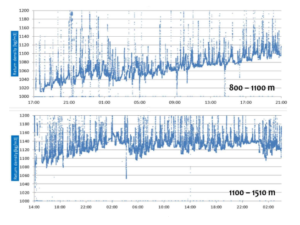
Large cuttings were observed at the shale shaker when drilling hard stringers while approaching the final well depth. Normally the cuttings were very fine and had particle size less than 1 mm. The large cuttings may have been created as a result of bit vibrations when drilling the hard stringers, due to relatively large bit cutter elements. It is interesting to note that the bottoms-up transport time for the cuttings is estimated to be 9 minutes at TD. Hence, the large cuttings may be valuable for formation evaluation.
Figure 4 shows the principal difference between the dual drill pipe circulating system (managed gradient drilling) and conventional MPD. The latter imposes a dynamic pressure gradient on the well annulus that may require installation of a casing or liner when the dynamic pressure exceeds the downhole pressure window. Managed gradient drilling, enabled by the dual conduit drill string, can provide a constant pressure gradient at all times, by adjustment of flow rates and surface choking, independent of whether the pumps are running.
Conclusions
The drilling operations verified all relevant procedures, including well control, as well as the model for hydraulics and reduced torque and drag. After implementing the heavy-over-light fluid configuration, the wellhead pressure was reduced from 362.6 psi to 43.5 psi and the string torque was reduced from 8.4 kNm to 6.2 kNm. Effective hole cleaning was also demonstrated at low flow, 800 to 1,000 l/min.
By validating the theoretical models, the field trial results demonstrate how the dual drill string method can be used to solve key torque, drag, hole cleaning and ECD control problems in horizontal wells. DC
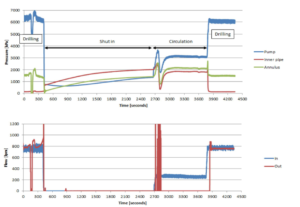
Acknowledgement
The drilling trial and development of the above described solutions was supported by DEA Deutsche Erdoel AG, Total, Petrobras, the Research Council of Norway and by the service partners Halliburton and Alcoa Oil and Gas. Thanks to the above mentioned parties for the support and for the permission to publish the results of the work. Special thanks also to Barlon Engineering, Calgary, for supporting the engineering and operational management, to Ensign Drilling for their proactive attitude and providing the rig and experienced operation personnel and to Twin Butte Energy for providing access to the field and for adminsterting the permissions to permit the operation.
References
- Vesavik et el. “Reelwell Drilling Method,” SPE/IADC 119491, Amsterdam, March 2009.
- Vestavik et al. “RDM-A Unique Combination of MPD and Liner Drilling,” SPE 124891, Aberdeen, Sept. 2009.
- Vestavik et al. “New Approach to Improve the Horizontal Drilling Reach,” SPE 137821, Calgary, Oct 2010.
- Belarde M et al., “Deployment of RDM in a Shale Gas Field in Canada,” SPE 145599, Aberdeen, Sept. 2011.
- Vestavik et al. “Extended Reach Drilling-new solution with a unique potential,” SPE 163463, Amsterdam, March 2013.
- “Extended Innovation,” European Oil and Gas magazine, pp 30-31, June 2014
-
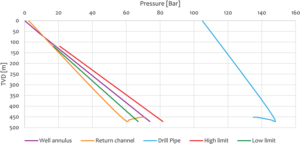
Figure 4 provides an example of the calculated pressure gradient in the trial well during the heavy-over-light drilling operation, with the pressure inside the well annulus and in the two channels of the dual drill string as a function of vertical depth. This example shows the advantage of the dual string configuration over conventional circulation. Vestavik O, “Cut, reach, clean and analyse,” Oilfield Technology pp 31-34, July 2014.
- Francis D, “ERD systems address downhole challenges,” Offshore Magazine pp 54-57 Sept 2014.
- Vestavik O, “Dual Drill String Technology improves ERD,” American Oil and Gas Reporter, pp 51-57, Sept 2014.
- Aleksandersen J et al. “Dual Drillpipe Method shows success in PMCD wells,” JPT, pp 32-35, April 2015.
- Vestavik O, “Conveyance in the Conduit,” Oilfield Technology pp 31-34, May 2015.
- Vestavik O. “Managed Gradient Drilling for improved horizontal reac.” Barents Drilling, ONS, Stavanger, Aug 2016.
- Vestavik O, et al., “Experience from Horizontal Drilling using Dual Drill Pipe,” GeoEnergy Celle, Germany, Sept 2016.
- Stranden E. “RDM-Experience ERD Trial,” NPF-Drilling Conference, Kr.sand, Norway, Sept 2016.
This article is based on SPE/IADC 184683, “Horizontal Drilling with Dual Channel Drill Pipe,” presented at the 2017 SPE/IADC Drilling Conference, 14-16 March, The Hague, The Netherlands.



